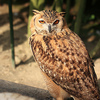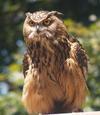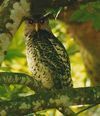Genus Bubo

Spotted Eagle-Owl - Spotted at the trey inhabit most of Africa south of the Sahara desert away from dense forests. They are diurnal hunters, spending the night concealed in trees, rock ledges or abandoned burrows. They are found in areas with rocky outcroppings, scrub land, open woods, and semi deserts. Spotted Eagle-owls do not avoid populated areas. They often hunt near roads and are often struck by vehicles. The major cause of death is pesticides used in agriculture for insect and rodent control.
Desert Eagle Owl - The Pharaoh Eagle-owl is a species of owl in the Strigidae family. It is found in Algeria, Chad, Egypt, Eritrea, Iraq, Israel, Jordan, Kuwait, Libya, Mali, Mauritania, Morocco, Niger, Oman, Qatar, Saudi Arabia, Senegal, Sudan, Tunisia, United Arab Emirates, and Western Sahara.
Indian Eagle Owl - The Rock Eagle Owl also called the Indian Eagle Owl or Bengal Eagle Owl is a species of large horned owl found in South Asia. They were earlier treated as a subspecies of the Eurasian Eagle Owl. They are found in hilly and rocky scrub forests, and are usually seen in pairs. They have a deep resonant booming call that may be heard at dawn and dusk. They are typically large owls, and have "tufts" on their heads. They are splashed with brown, and grey and have a white throat patch with black small stripes.
Eagle Owl - The Eagle Owl is a large and powerful bird, smaller than the Golden Eagle but larger than the Snowy Owl. It is sometimes titled the world's largest owl, but so is the Blakiston's Fish Owl, which is slightly bigger on average. The Eagle Owl has a wingspan of up to 138–200 cm and measures 58–73 cm long. Females weigh 1.75-4.2 kg and males weigh 1.5-3.2 kg . In comparison, the common Barn Owl weighs about 500 grams . It mainly feeds on small mammals, but can kill prey up to the size of foxes and young deer , if taken by surprise. Larger prey is consumed on the ground which leaves the bird vulnerable .
Cape Eagle-Owl - There are three subspecies: capensis , mackinderi , and dilloni . The distribution of all three is patchy. The subspecies mackinderi, which is slightly bigger than the others, is sometimes split as Mackinder's Eagle-owl, Bubo mackinderi.
Dusky Eagle-Owl - The nesting season is from November to April.
Verreaux's Eagle-Owl - Verreaux's Eagle-owl ranges from 66–75 cm in length. This species can attain a wingspan 2 m and weighs from 1600 to 3115 grams , orange eyes and two feather tufts on their ears. Their feathers are dark brown on top and light grey below.
Akun Eagle Owl - The Akun Eagle-owl is a species of owl in the Strigidae family. It is found in forests in Central and Western Africa. At 43 centimetres , it is the smallest eagle-owl in Africa and also the only African rainforest eagle-owl with yellow eyes.
Forest Eagle Owl - The Spot-bellied Eagle-owl is nocturnal and spends the day hidden among foliage of a large forest tree. At dusk it becomes active and hunts small mammals, reptiles, and birds up to the size of junglefowl.
Philippine Eagle-Owl - With a total length of 40–50 cm and a wing-length of about 35 cm , it is the largest owl in the Philippines, but among the smallest members of the genus Bubo. It is overall rufous with a lighter belly and yellow eyes.
Fraser's Eagle Owl - The Fraser's Eagle-owl is a species of owl in the Strigidae family. It is found in Angola, Cameroon, Central African Republic, Republic of the Congo, Democratic Republic of the Congo, Ivory Coast, Equatorial Guinea, Gabon, Ghana, Liberia, Nigeria, Rwanda, Sierra Leone, and Uganda.
Shelley's Eagle-Owl - The Shelley's Eagle-owl is a species of owl in the Strigidae family. This dark eagle-owl is found in Central and Western Africa, but it is local and generally rare. At about 58 centimetres , it is the among the largest owls in the world and by far the largest eagle-owl found in the African rainforests. It is threatened by habitat loss.
Barred Eagle-Owl - The Barred Eagle-owl , also called the Malay Eagle Owl, is a species of owl in the Strigidae family. It is found in Brunei, Cocos Islands, Indonesia, Malaysia, Myanmar, Singapore, and Thailand. Its natural habitat is subtropical or tropical moist lowland forests.
Great Horned Owl - Strix virginiana Gmelin, 1788 and see text
Nduk Eagle-Owl - Its natural habitats are subtropical or tropical moist lowland forests and subtropical or tropical moist montane forests. It is threatened by habitat loss.










